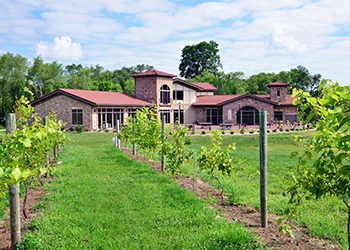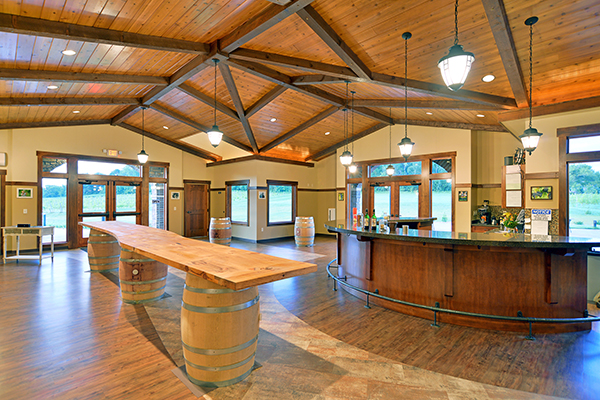Crafting an Experience: Western Wisconsin Winery Design Wows Guests
 On a recent midsummer’s eve at the Belle Vinez Winery, a soft light cast an ephemeral glow over the vineyard’s gently rolling hills, where rows of succulent grapes drooped from lush green vines. Friends lounged in the courtyard of the wood-timbered, tile-roofed, brick and limestone winery’s courtyard, casually clinking their glasses in a toast to all good things as they sampled wines crafted just a few feet from where they were sitting.
On a recent midsummer’s eve at the Belle Vinez Winery, a soft light cast an ephemeral glow over the vineyard’s gently rolling hills, where rows of succulent grapes drooped from lush green vines. Friends lounged in the courtyard of the wood-timbered, tile-roofed, brick and limestone winery’s courtyard, casually clinking their glasses in a toast to all good things as they sampled wines crafted just a few feet from where they were sitting.
Sound like a scene from Italy?
If so, that was the Zimmerman family’s goal as they worked with Ayres Associates to design their winery in rural River Falls in western Wisconsin. Inspired by a visit to Tuscany with friends more than a decade ago, the building’s design focused on helping guests experience the essence of that Tuscan experience – enjoying time connecting with friends and family over a good glass of wine in a beautiful venue.
 “We wanted to make this great experience where someone could feel like they took a mini vacation, where they could imagine they weren’t here in western Wisconsin,” explains Angel Zimmerman. She and her husband, Shannon, own the winery; son Josh manages it; and most of the winery’s employees are family members.
“We wanted to make this great experience where someone could feel like they took a mini vacation, where they could imagine they weren’t here in western Wisconsin,” explains Angel Zimmerman. She and her husband, Shannon, own the winery; son Josh manages it; and most of the winery’s employees are family members.
From the beginning the family wanted a Tuscan-themed building with a “wow factor” to set it apart from other wineries in the St. Croix Valley. But how do you recreate Tuscany in a state more known for its cheese than its vineyards?
The project began with the owners sharing photos from their Tuscany trips with the project principal.
As project manager/architect Mark Paschke, and others, researched Tuscan architecture, they observed that wineries often feature a cluster of brick and stone buildings that have been added on to or connected to over a long period of time, often around an outdoor plaza or courtyard space. Belle Vinez’s design conveys that idea by arranging a series of building masses – yet keeping it all one building – around a central, south-facing courtyard.
The owners and designers took a field trip to a local quarry, where they could see and touch stone to get a sense of colors, textures, and patterns. In addition to selecting local stone, the field trip resulted in an unexpected surprise. They came across a pile of recycled brick pavers estimated to be more than 100 years old that were taken from a street in St. Paul, Minnesota. To help create an “old world” feel, the pavers were sawn in half and used on part of the building, preserving old mortar scuffs and tar from the bricks’ previous life.
Other materials that helped convey the Tuscan look without importing expensive materials included wood ceilings and wood beams, plus a metal roof that looks like a red clay tile roof but is a better fit for a northern climate. Interior designer Anne Peterson helped value-engineer some of the interior finish selections. Those included luxury vinyl tile (LVT) that looks like wood planks and stone tile to create a rustic look that matches the architecture, yet will also hold up under high traffic, be easy to maintain, and cost considerably less than traditional wood and stone flooring.
To help visualize the finished building, the design team created 3-D renderings to show what the actual material selections would look like on a larger scale.
Since opening in mid-May, the building has been a draw in itself. “Our guests are saying they knew the building would be nice, but they didn’t know how nice,” Angel says.
Belle Vinez brings a taste of Tuscany to western Wisconsin, and wineries throughout Wisconsin and the rest of the nation provide getaways for those who appreciate wine as well as architecture. According to this story from the St. Paul Pioneer Press, the Midwestern wine industry owes its existence to the development of cold-hardy yet wine-worthy grape varieties.
It makes sense to add wine to the list of Midwestern agricultural specialties. After all, the cheese for which Wisconsin is known is also a fermented product. UW-Madison has recognized the importance – and growth – of this spirited industry in Wisconsin by adding a wine and cider outreach specialist to the College of Agricultural and Life Sciences. The story notes that approximately 10 new wineries, 10 new breweries, and 10 new distilleries start in Wisconsin each year.
If your tastes run more toward another traditional Wisconsin product – beer — you can wet your whistle with Leinenkugel products at the Leinie Lodge in Chippewa Falls, another Ayres-designed project, pictured below.
What’s your pleasure? Tell us about your favorite winery/brewery getaways, whether in the Midwest or elsewhere in the world. (And for a look at stunning wineries around the globe, check out these Architectural Wine-World Wonders.)

Comments
The surroundings are beautiful and the structures are great but what can’t be duplicated is the great customer experience these people provide.
they get it !!

Post a comment: